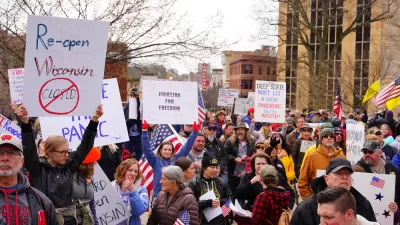Initial research on social isolation as a method to combat contagious disease included a high-school science fair project modeling social networks. Doctors learned that the spread of disease could be decelerated by disrupting these networks.

Most people became aware of social distancing when guidelines and restrictions related to reducing the spread of the coronavirus circulated worldwide. In a New York Times piece, Eric Lipton and Jennifer Steinhauer tell the origin story of the concept of social distancing—a story that began about a decade and a half ago when George W. Bush, concerned by bioterrorism, requested research to ensure that the United States would be prepared in the event of an outbreak of infectious disease.
When Department of Veterans Affairs physician Dr. Mecher and oncologist and White House advisor Dr. Hatchett presented their research on previous pandemic outbreaks, they received what Dr. Mecher politely describes as an "ugly" response.
"When they presented their plan not long after, it was met with skepticism and a degree of ridicule by senior officials, who like others in the United States had grown accustomed to relying on the pharmaceutical industry, with its ever-growing array of new treatments, to confront evolving health challenges," explain Lipton and Steinhauer. Despite resistance, the Bush administration and the Centers for Disease Control adopted the Non-Pharmaceutical Interventions or NPI as official policy.
FULL STORY: The Untold Story of the Birth of Social Distancing

Alabama: Trump Terminates Settlements for Black Communities Harmed By Raw Sewage
Trump deemed the landmark civil rights agreement “illegal DEI and environmental justice policy.”

Planetizen Federal Action Tracker
A weekly monitor of how Trump’s orders and actions are impacting planners and planning in America.

The 120 Year Old Tiny Home Villages That Sheltered San Francisco’s Earthquake Refugees
More than a century ago, San Francisco mobilized to house thousands of residents displaced by the 1906 earthquake. Could their strategy offer a model for the present?

In Both Crashes and Crime, Public Transportation is Far Safer than Driving
Contrary to popular assumptions, public transportation has far lower crash and crime rates than automobile travel. For safer communities, improve and encourage transit travel.

Report: Zoning Reforms Should Complement Nashville’s Ambitious Transit Plan
Without reform, restrictive zoning codes will limit the impact of the city’s planned transit expansion and could exclude some of the residents who depend on transit the most.

Judge Orders Release of Frozen IRA, IIJA Funding
The decision is a victory for environmental groups who charged that freezing funds for critical infrastructure and disaster response programs caused “real and irreparable harm” to communities.
Urban Design for Planners 1: Software Tools
This six-course series explores essential urban design concepts using open source software and equips planners with the tools they need to participate fully in the urban design process.
Planning for Universal Design
Learn the tools for implementing Universal Design in planning regulations.
Clanton & Associates, Inc.
Jessamine County Fiscal Court
Institute for Housing and Urban Development Studies (IHS)
City of Grandview
Harvard GSD Executive Education
Toledo-Lucas County Plan Commissions
Salt Lake City
NYU Wagner Graduate School of Public Service





























